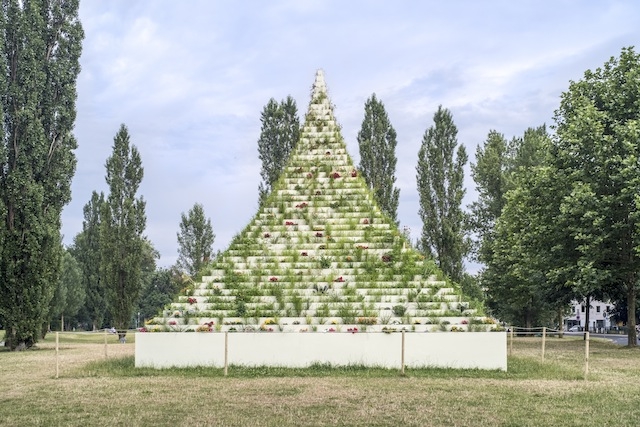Searching for a way through the quinquennial’s sprawling second instalment
On the opening day of Documenta 14 I finally gave up on a press conference that, entering its third doleful hour, had included a lengthy violin performance and a fair bit of theorising but little about the art. Tetchily disregarding artistic director Adam Szymczyk’s request that we begin our tours in a disused railway tunnel, I elected to start in Kassel’s northeast and work diagonally southwest. This meant encountering, in short order, a piece of space-eating eco-kitsch, The Living Pyramid (2015/17), a ziggurat covered in pot plants by the usually dependable Agnes Denes; a makeshift Cuban bar/performance space that wasn’t quite open (and would later be rented out for private functions); and the first of several scrappy group exhibitions that felt like degree shows. But at least these could be relatively easily found.
Soon after, alongside a couple of befuddled museum directors, I was looking in vain for signage to the huge yet hidden-away Neue Neue Galerie (a former post office renamed for the occasion). When located it featured another disjointed sprawl, from Rasheed Araeen’s archive of his Third Text magazine plus multihued abstractions (The Reading Room, 2016–7), to Dan Peterman’s iron ingots, to a shutdown performance space by Otobong Nkanga, to things I couldn’t identify because they weren’t labelled. Some of the wall labels present were handwritten and had question marks after the artists’ names; ‘soft launch’ would be a kind characterisation here. Back at the press conference, Bonaventure Soh Bejeng Ndikung (of Berlin art lab Savvy Contemporary) had spoken of positive uncertainty, and Szymczyk, at Documenta’s first half in Athens, had relatedly encouraged audiences to ‘unlearn what you know’. Any irritation at slapdash presentation and organisational chaos, then, is merely a teachable moment in disguise.
Szymczyk’s vision for Documenta is laudable in theory. Pointedly internationalist, his show features few biennale darlings among its 160-plus artists, making it an antimarket statement of sorts; and in its contrast of German prosperity and Greek austerity it aims at some kind of core critique, many-tentacled, often curving back to the toxic upshots of capitalism though also wildly tangential. The opening sequence of works in the nineteenth-century Neue Galerie, for example, indicts money as the root of all evil, from two fifteenth-century tempera paintings of Saint Anthony Tempted by Gold to etchings and sculptures of beggars, to cloudy alternative-currency concepts including Pierre Zucca’s nude-woman-laced performance photographs The Living Currency (c. 1970). Soon after, we’re in a cool roomful of R.H. Quaytman paintings where, as one might half-expect, Paul Klee’s 1920 Angelus Novus makes an appearance in reproduction (leading, of course, to Walter Benjamin and the Angel of History). And then we’re processed through flotillas of historical works – for the first time, Documenta is using this large museum’s entirety – that dwell on war, colonialism, famine, racism, disasters of all stripes. Much of the art is fascinating, from Indian artist K.G. Subramanyan’s fragmentary terracotta reliefs to Polish avant-gardist Władysław Strzemiński’s filtering of Nazi horrors through quivery pencilled semiabstractions, but the sheer girth and relentless tone of bleak realism are exhausting. And then there are 32 other exhibition venues.
The most navigable is the suavely postmodernist, airy Documenta Halle, where intertwining subthemes of listening and the libidinal manifest in works engaging with sound, scoring and bodily movement, from Alvin Lucier’s confections of speakers and framed paper, Sound on Paper (1985), to archival images relating to Anna Halprin’s 1960s and 70s dance workshops, to Igo Diarra and La Medina’s funky minishrine to Malian guitarist Ali Farka Touré, Learning from Timbuktu (2017). There’s also an audio archive of sound-based activities from the Athens leg of Documenta: a literalising, really, of the metaphoric notion of ‘listening to Athens’. (In the Fridericianum, meanwhile, listening becomes looking, in the shape of a giant info-dump of works from Greece’s National Museum of Contemporary Art’s collection.) This tickling of senses other than the visual brings one back to the bodily, hence the room of Miriam Cahn’s paintings – vivid, pained, ripe-coloured bodily figurations – might seem to belong too. Mostly, though, one lingers amid these because they’re tangibly great, not because they’re a stitch in the curators’ giant tapestry.
One of the dreamier-sounding venues is the Glass Pavilions: whatever Oz-like destination one pictures, though, this turns out to be a series of boxlike, glass-sided abandoned shopfronts on a busy main road, a number of them containing mini-exhibitions you can’t enter, and a few – like a relaxed hang of Vivian Suter’s warm unstretched abstract paintings – that you can. It seems pivotal that this is a particularly cosmopolitan part of Kassel, where migrant communities intersect: Turkish, Ethiopian, Bulgarian, Syrian. As with Athens, Szymczyk and co are evidently bent on having the viewer explore the city’s extramural textures, even if often searching for something while doing so.
Yet aside from largescale single works like Marta Minujín’s The Parthenon of Books (1983/2017), a giant architectural mirroring of the Athens landmark in whose plastic-sheeting wrapping countless historically banned books are sealed, moments like the Glass Pavilions – where one can traverse a section without getting footsore or forgetting how it started – are welcome exceptions. Documenta 14 may present itself as antimoney, outwardly at least (the curators nevertheless borrowed from private collections) but it also determinedly chases cultural capital for its makers via darkly symphonic epicness and default handwringing. The result, inadvertently pointing up some of the artworld’s more pressing structural problems, is overwhelming but not in a good way: despite featuring many strong individual works, it’s simply not humanly scaled, continuously blurring its position, losing its signals in the noise of stymied reception. That doesn’t seem to matter to the organisers, who aren’t suffering continuous FOMO because they’ve seen it all – maybe – and aren’t mindful of hurrying to the next grand event, ie Skulptur Projekte Münster, which opened a couple of days after Documenta did. As for the viewers? They can get lost.
